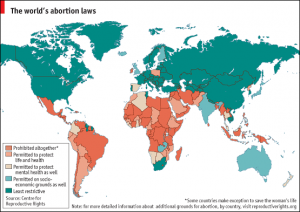We will review the different methods of abortion currently used in the United States. Here we will give you a detailed overview of medical abortions.
What is a Medication Abortion?
They often go by various names:
-
- Medication Abortion
- Medical Abortion
- Abortion Pill
- RU-486
History of Medication Abortion
In 2000, the United States Food and Drug Administration (FDA) approved two abortion pills. The two medicines are mifepristone and misoprostol. [1]
In 2016, the FDA approved a new label for the medicines. This change allowed for lower dosages, increased gestational age limit, and fewer follow up visits.
How Common is Abortion by Medication?
Medication abortion is increasingly popular. It accounted for 6% of nonhospital abortions in 2001, and 31% by 2014 (the most recent year for which data are available according to the Guttmacher Institute, the former research arm of Planned Parenthood). [2]
This is for several reasons.
Medication abortion is cheaper for abortion providers. A patient is typically charged the same amount for either a medication abortion or a surgical abortion. The medication abortion, though, takes less manpower, clinic time, and does not involve anesthesia. The woman is responsible for giving herself Ibuprofen and relieving her own pain outside the clinic.
Also, abortion advocates want nurse practitioners and physician assistants to offer medication abortion. They say that simply performing a physical exam and giving a pill does not require a doctor. Pro-life advocates point out that abortion is not routine healthcare, and that it’s potentially very serious consequences deserve the oversight of an actual physician.
Prescribed medicines usually come from a pharmacy, and the patient can ask the pharmacist if they have questions. The abortion pill is only available at an abortion clinic. The abortion doctor signs very detailed paperwork about the abortion medicines and returns it to the manufacturer.
What happens during a Medication Abortion?
First, an ultrasound is done to confirm that the pregnancy is intrauterine (inside the uterus) and not ectopic (growing outside the uterus). A nurse or other staff member takes the woman’s vital signs like heart rate and blood pressure. The abortion doctor also listens to the woman’s heart and lungs with a stethoscope and does a pelvic exam, except in webcam abortions (see below). Sometimes, the woman receives antibiotics to prevent infection.
Mifepristone or Mifeprex or RU-486, is the first medicine. It is given to the woman at the abortion clinic. Misoprostol is the second medicine. The woman takes Misoprostol at home.
The abortion usually takes 24-48 hours after the second medicine, Misoprostol, is taken. The woman signs a Patient Agreement Form that she will come back for a follow up appointment in 14 days. This is to be sure that the abortion worked. In 2-7% of cases, this type of abortion does not work. If that happens and the woman is still pregnant, she is then encouraged to have a surgical abortion such as a dilation and curettage (D&C). If she chooses to carry the baby to term after a failed medication abortion, the baby might have birth defects.
About the Drugs used in Medical Abortion
Mifepristone works by blocking progesterone. Progesterone is the hormone that sustains pregnancy. Without progesterone, the lining of the uterus breaks down and sheds like in a menstrual period. This cuts off nutrients and support to the fetus. [3]
Misoprostol was first developed to prevent stomach ulcers in people who take nonsteroidal anti-inflammatory drugs (NSAIDs) like ibuprofen or advil. [4] Another way it works is by releasing prostaglandins in the body. This effect is the reason Misoprostol is part of medication abortions. Prostaglandins cause the uterus to have contractions and expel the dead fetus. This happens while at home and the fetus is usually expelled into the toilet. These strong uterine contractions are said to feel like the pain from very strong period cramps. According to Planned Parenthood’s own website, fetal tissue may be visible along with “lots of bleeding.”
In very rare cases, when a woman is allergic to Mifepristone, a different medication called Methotrexate may be used by itself without the Misoprostol. Methotrexate is typically a chemotherapy medication or a rheumatoid arthritis treatment. In medication abortion, it kills the embryo by stopping the reproduction of fast-growing fetal cells.
At what point does the Fetus die?
Typically, the fetus dies when its nutrients are cut off because of the first abortion medicine, Mifepristone.
What Percentage of Abortions are Medication Abortions?
Medication abortion is increasingly popular. It accounted for 6% of nonhospital abortions in 2001, and 31% by 2014 (the most recent year for which data are available according to the Guttmacher Institute, the former research arm of Planned Parenthood). [5]
This is for several reasons.
Medication abortion is cheaper for abortion providers. A patient is typically charged the same amount for either a medication abortion or a surgical abortion, but the medication kind takes less manpower, clinic time, and does not involve anesthesia. The woman is responsible for giving herself ibuprofen and relieving her own pain outside the clinic.
Also, abortion advocates want nurse practitioners and physician assistants to offer medication abortion. They say that simply performing a physical exam and giving a pill does not require a doctor. Pro-life advocates point out that abortion is not routine healthcare, and that it’s potentially very serious consequences deserve the oversight of an actual physician. Prescribed medicines usually come from a pharmacy, and the patient can ask the pharmacist if they have questions. The abortion pill is only available at an abortion clinic. The abortion doctor signs very detailed paperwork about the abortion medicines and returns it to the manufacturer.
Side Effects of the Abortion Pills [6]
Abortion is never safe for the developing embryo or fetus. A medication abortion is also not safe for women themselves who meet any of the following criteria:
-
- Pregnancy greater than 10 weeks along
-
- An ectopic pregnancy, also known as pregnancy outside the uterus
-
- Have an intrauterine device (IUD) currently in place
-
- History of adrenal gland problems
-
- Take blood thinners
-
- Have a blood clotting disorder or other bleeding problem
-
- Have porphyria
-
- Take steroids
- Have an allergy to misoprostol, mifepristone, or other prostaglandins
Common side effects up to 24 hours after taking the medicines can include:
-
- Nausea/vomiting
-
- Weakness
-
- Fever/chills
-
- Headache
-
- Diarrhea
- Dizziness
Rare but serious side effects include:
-
- Life-threatening bleeding requiring hospitalization and possibly a blood transfusion
- Life-threatening infection
Bleeding is not listed as a side effect because it is expected. This does not mean that the amount of bleeding will necessarily be safe. Serious or life-threatening bleeding is more likely with medication abortion because of the way the medicines work. Since every woman’s body reacts differently to medications, some women’s bodies may not automatically stop bleeding and contracting just because the fetus has already been expelled. This can progress to life-threatening bleeding depending on how much the woman bleeds and how long she bleeds for.
Additionally, there is a risk of infection. This risk is highest for women who experience “incomplete abortion.” This is when the fetus is dead and expelled but the body retains some of the membranes or placenta that were supporting it. [7]
How often do Complications occur?
In a 2014 research study in California, there were four times as many complications from medication abortions as surgical abortions in the first trimester. About 5.2% of women had to go to the emergency room for a medication abortion complication. [8] In another research study in Finland, there were four times as many complications from medication abortions at or before 7 weeks gestational age compared to surgical abortions. 20% of women, or 1 in every 5 women, who had medication abortions in the study experienced a complication. [9]
Deaths from the Abortion Pill
After the original FDA protocol was released in 2000, eight young women who took Misoprostol vaginally died of a bloodstream infection caused by clostridium sordelli bacteria. The FDA protocol did not mention vaginal use, but this “off-label” use was common at the time. The FDA said those deaths were “infection-related” rather than “abortion-related. ” Nowadays, Misoprostol is no longer used vaginally. It is placed inside the cheek until it dissolves.
In total, 22 women who took RU-486 have died since 2000. 2 of those women died from ruptured ectopic pregnancies, even though the FDA insert says that no woman with an ectopic pregnancy should take RU-486. [10]
In 2016, the FDA accepted off-label dosages that were being widely used by abortion doctors, instead of the dosages from the 2000 protocol. When this protocol change was made, no safety research studies were cited.
What are Webcam or Telemedicine Abortions?
Telemedicine or “webcam” abortions are becoming more popular. After an ultrasound and a review of the woman’s medical history, she takes the first medicine in clinic. A physician watches remotely on a webcam. Abortion advocates say that webcam abortions give rural woman more access. Pro-life advocates point out that women miss out on an actual physical examination. Also, living in rural areas could mean less access to a hospital when complications occur. Iowa was the first state to pilot webcam abortions, and Sue Thayer managed a Planned Parenthood clinic there. She was fired for refusing to participate.
As this article was being written, California’s legislature is considering HB320, which would mandate that health centers at state-run colleges and universities dispense abortion medicines.
What if I Change my Mind?
For women who have only taken Mifepristone and change their minds, stopping the abortion may be possible. A large dose of oral progesterone may be able to reverse Mifepristone’s effects. In a research study, the abortion was effectively stopped in 68% of patients who took the progesterone. More information is available here: https://abortionpillreversal.com/
What does Baby Look Like at 10 weeks?
At 10 weeks, the brain, heart, lungs, liver, and kidneys are all formed. Baby’s heart has been beating since about 3 weeks. Baby’s fingernails and hair are starting to grow.





 In 1973, the Roe v. Wade
In 1973, the Roe v. Wade  In this case, Jane Roe (her actual name is Norma McCorvey), had wanted an abortion, but was not legally allowed to receive one in her home state of Texas [1].
In this case, Jane Roe (her actual name is Norma McCorvey), had wanted an abortion, but was not legally allowed to receive one in her home state of Texas [1].
